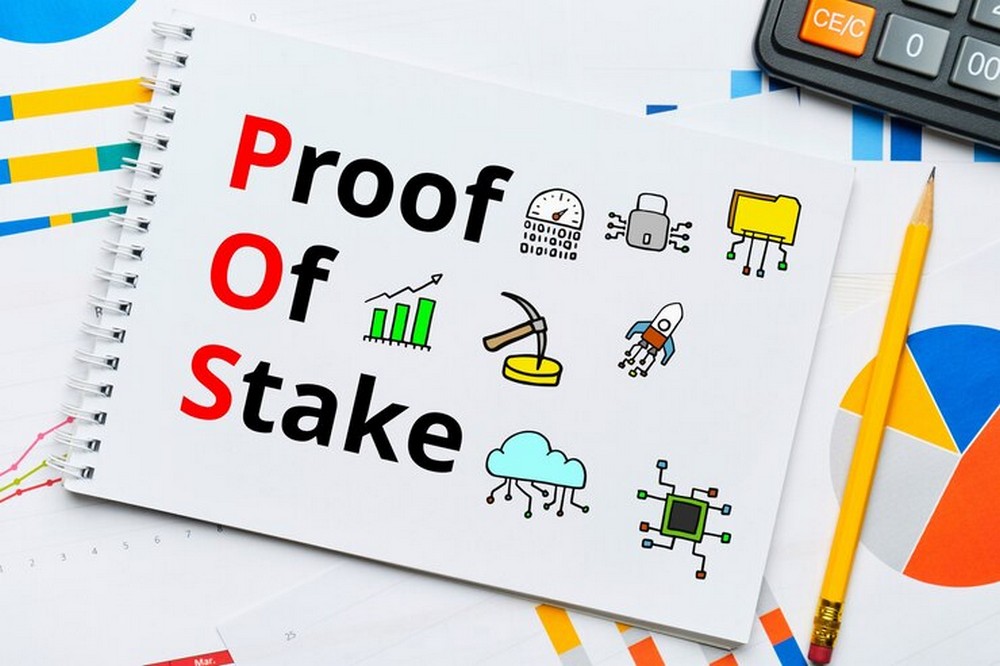 Strategies of hedging: definition, benefits and risks for traiders
Strategies of hedging: definition, benefits and risks for traidersIt is in human nature to constantly look for quick ways of money-making that do not require much effort or time commitment. Cryptocurrency staking is all about that – generating some income in an easy, hands-free manner.Staking has become a buzzword nowadays as people’s interest toward cryptocurrencies seems to be ever-increasing, irrespective of everything. We constantly encounter splashy headlines telling us that a newly-minted millionaire has built their six-figure fortune on crypto staking, and this surely inspires many of us to replicate that success.If you want to engage in cryptocurrency staking but do not know where to start, this guide highlights the key aspects of the matter to help you break the ground.
What Is Cryptocurrency Staking?
In a broad term, cryptocurrency staking is a way to gain extra profit on your crypto holdings. Similar to traditional savings accounts in a bank, cryptocurrency staking involves locking (keeping) your digital funds in your wallet for a certain period, during which you should not withdraw your assets to receive rewards. Staking is an integral part of many cryptocurrency networks that need users’ lock-ups (deposits) to verify transactions and add blocks to the underlying blockchain. Crypto networks that offer staking employ a so-called proof-of-stake (PoS). Under this consensus mechanism, coin owners process transactions within the blockchain and get compensated for their work based on the size of their stake.Unlike proof-of-work (PoW) crypto systems (such as the Bitcoin Blockchain) where members need to solve complex mathematical equations to add a new block to the blockchain and receive a reward, PoS networks (such as the Solana Blockchain) only require holding tokens in a crypto wallet for a fixed amount of time without spending to be rewarded.Moreover, PoW systems demand members to invest in expensive mining hardware that consumes a lot of electricity to cope with mathematical puzzles, while PoS schemes only require a wallet and a stake to participate in a network and get rewards.
Staking is an integral part of many cryptocurrency networks that need users’ lock-ups (deposits) to verify transactions and add blocks to the underlying blockchain. Crypto networks that offer staking employ a so-called proof-of-stake (PoS). Under this consensus mechanism, coin owners process transactions within the blockchain and get compensated for their work based on the size of their stake.Unlike proof-of-work (PoW) crypto systems (such as the Bitcoin Blockchain) where members need to solve complex mathematical equations to add a new block to the blockchain and receive a reward, PoS networks (such as the Solana Blockchain) only require holding tokens in a crypto wallet for a fixed amount of time without spending to be rewarded.Moreover, PoW systems demand members to invest in expensive mining hardware that consumes a lot of electricity to cope with mathematical puzzles, while PoS schemes only require a wallet and a stake to participate in a network and get rewards.This makes PoS systems more eco-friendly and cost-effective than PoW ones, explaining why more and more users are flocking to proof-of-stake projects to earn coins without much initial investment.
How Does Crypto Staking Work?
To get down to the crypto staking business, a person first needs to buy a certain amount of the native digital currency of some blockchain project that operates on a proof-of-stake mechanics. Luckily, there is no shortage of crypto projects that are hosted on PoS-optimized blockchains, including Polkadot, Avalanche, Solana, Tron, Binance Smart Chain (BSC), and Cardano among other blockchain networks.Cryptocurrencies can be purchased through specialized crypto exchanges – such as Binance or Coinbase – and directly from crypto wallets that offer fiat-to-crypto payments. MetaMask is one of the best crypto wallets where you can buy digital assets within minutes, using your bank card.Crypto exchanges and wallets are also immediate gateways to cryptocurrency staking as they provide an opportunity to open a position and receive rewards without leaving the app. The process of opening a staking position is very straightforward, yet it may vary from platform to platform. You generally need to sign in to an exchange/wallet, navigate to the “Staking” page (sometimes, it is called “Earn”), choose the coin you want to lock up, and follow the instructions given by the platform.
The process of opening a staking position is very straightforward, yet it may vary from platform to platform. You generally need to sign in to an exchange/wallet, navigate to the “Staking” page (sometimes, it is called “Earn”), choose the coin you want to lock up, and follow the instructions given by the platform.Many crypto exchanges and wallets take the process of staking to the next level by offering such nifty features as staking pools. These pools aim to help users get more profits from their stake by combining their smaller stakes in a larger, collectively formed deposit (a pool).
How to Become a Crypto Stakeholder?
Embarking on cryptocurrency staking is a simple process hands-down. For this, you only need to hold some proof-of-stake cryptocurrency because only PoS digital assets are suitable for staking. The good news is that PoS coins are found in abundance these days because this model of earning a passive income is gaining traction. Choosing the right crypto coin is, perhaps, the hardest aspect of the entire staking process. You should do your homework to research the market and pick the asset with the potential for growth. In the upshot, you do not want to end up with the coin of your choice to completely lose its value once the staking period is over.It may be tempting to gravitate toward a cryptocurrency that offers huge staking rewards of 100% or even higher APR (annual percentage rate), but such cryptocurrencies may depreciate in price very quickly. You should only buy a coin you are sure its value will only increase over time.
Choosing the right crypto coin is, perhaps, the hardest aspect of the entire staking process. You should do your homework to research the market and pick the asset with the potential for growth. In the upshot, you do not want to end up with the coin of your choice to completely lose its value once the staking period is over.It may be tempting to gravitate toward a cryptocurrency that offers huge staking rewards of 100% or even higher APR (annual percentage rate), but such cryptocurrencies may depreciate in price very quickly. You should only buy a coin you are sure its value will only increase over time.Now that you have decided on the coin you want to stake, the next step is to purchase it. The obvious way to obtain cryptocurrencies is through crypto exchanges.
Where to Stake Cryptocurrencies?
There is a smorgasbord of staking options currently available. Many crypto exchanges, wallets, and cryptocurrency projects offer incentives for users who choose to lock up their funds for a while to maintain the network’s performance. The main entry points to cryptocurrency staking include the following:
The main entry points to cryptocurrency staking include the following:- Exchanges. There are centralized and decentralized crypto exchanges that come with staking opportunities. On centralized exchanges, you will have to undergo a KYC (know your customer) procedure, verifying your identity and financial data by uploading a copy of your government-issued document, a photograph, and some other papers. In contrast, decentralized crypto exchanges require much fewer formalities to get started. Popular centralized exchanges include Binance and Coinbase. Trusted decentralized alternatives are Uniswap, Trader Joe, and Serum.
- Wallets. Many cold (hardware) and hot (software) cryptocurrency wallets are loaded with a staking module. A stakeholder needs to keep their stake in the wallet until the lock-up period is over, otherwise, the rewards will not be credited. The leading cryptocurrency wallets that support in-app staking include Ledger, Trust Wallet, Trezor, MetaMask, Atomic Wallet, and Exodus.
- Staking-as-a-Service (SaaS) Platforms. Unlike cryptocurrency exchanges and wallets, which are used as a means of trading and storage respectively, SaaS platforms are designed for staking only. However, these platforms will charge a percentage from the rewards you earn. Staking through SaaS platforms is also known as soft staking, and the most popular providers are Stake Capital and MyCointainer.
- DeFi Projects. Decentralized finance (DeFi) projects are blockchain-enabled applications that offer various financial services like regular banks do. These services include borrowing, lending, savings, insurance, and, surely, staking. On DeFi platforms, a user can lock their digital assets such as coins or non-fungible tokens (NFTs) into smart contracts that are hosted on a PoS-friendly blockchain. In return, a user receives compensation for the duties their staking performs. Generally, staking is necessary to enter transactions into the respective blockchain as well as maintain the security and integrity of a particular DeFi platform. There are hundreds of up-and-running DeFi projects, with new ones popping at an increased frequency. Some notable DeFi systems encompass DeFi Swap, Aqru, YouHodler, Nexo, and others.
What Are Staking Risks?
Staking presents a great way to establish a secondary revenue stream, but this activity is not without its pitfalls. Before you invest your hard-earned money in some blockchain project, you should be aware of potential risks associated with crypto staking.- Financial risk. The market of cryptocurrencies is extremely volatile, where crypto prices can plummet and skyrocket within a ridiculously short span of time. The platform of your choice can offer lucrative rewards, but if the price of the staked digital asset drops, you may incur losses.
- Liquidity risk. In the crypto world, liquidity indicates the desire of other people to obtain the asset you want to get rid of. If you are not able to convert your crypto rewards into fiat or swap them for a different crypto, you may still end up gaining nothing from staking.
- Lock-in risk. When you stake a cryptocurrency, you must agree to a minimum lock-in period. During this period, you cannot touch your staked funds, which remain locked on the network. Moreover, un-staking a cryptocurrency usually takes a long time (up to three weeks or more), and if prices fall during this period, you can withdraw tokens for a much lower price than when you deposited it. Plus, you will not receive a reward if you close the staking position before the due date.
- Hacker attacks. Crypto platforms are desirable targets for cyber criminals. Malicious actors can take advantage of the platform’s software vulnerability to steal user funds, including locked deposits. Other scammers use different foul means to defraud naive people out of their crypto funds.
- Slashing risk. Whether you stake cryptocurrency independently or through a pool, you become a validator on the network every time you open a new staking position. And this involves certain responsibilities. You should always have your machine online, as the blockchain performance depends on the consistency of its validators. An offline machine may negatively impact the functioning of the network. If this happens, the network may impose a penal charge on your rewards. These penalties can be minimal or very significant, depending on the blockchain.
- Government risks. National governments are continuously clamping down on cryptocurrencies, trying to take this industry under total control. Politicians at all levels adopt laws and regulations that either restrict or even prohibit the use of cryptocurrencies, making it hard or impossible for investors to engage in staking and other crypto activities.

How to Manage Staking Risks?
A robust risk management strategy should be considered when you decide to get into crypto staking. Here are some tips that will help you safely get ahead with staking.- Avoiding staking risks starts with being ultra-selective when it comes to choosing a platform to deal with. You should do your due diligence and carefully review the blockchain project before pledging your money to it. Just like with any type of investment, it is important to never stake more than you can safely afford to lose.
- Acknowledge that many platforms offer staking with rigid lock-ups. During the lock-up period, your digital funds become inaccessible. If you decide to remove your locked deposit before the due date, you will still have to wait several days or even weeks before you get your assets back in your control. To mitigate this risk, try to opt for flexible staking options.
- Thoroughly research the platform in terms of security before opening a staking position on it. The platform is considered secure if its software has been checked by reputable cybersecurity agencies.
- Establish multi-factor authentication because it is a powerful security tool to keep your digital assets out of unauthorized reach. Email verification, SMS code confirmation, and multi-signature authentication are some of the best crypto risk management practices.
- You should also consider complete non-disclosure of any information concerning your personal crypto holdings. You should never let anyone know that you own any cryptocurrencies, or engage in crypto staking; otherwise, you may become an unintentional target for hackers and scammers.
- Portfolio diversification is also among powerful measures to minimize crypto staking hazards. It means you stake through different platforms and through different blockchains. Even if one system shuts down, diversification helps you balance the risk of the portfolio losing significant value because of a single asset.
- Before becoming a stakeholder, you should get a grasp on the local cryptocurrency regulations to ensure your crypto activities stay compliant with the law in your jurisdictions. In many countries including the USA, you will also need to pay taxes on capital gains from crypto.
Comments
Subscribe
Login
0 Comments







